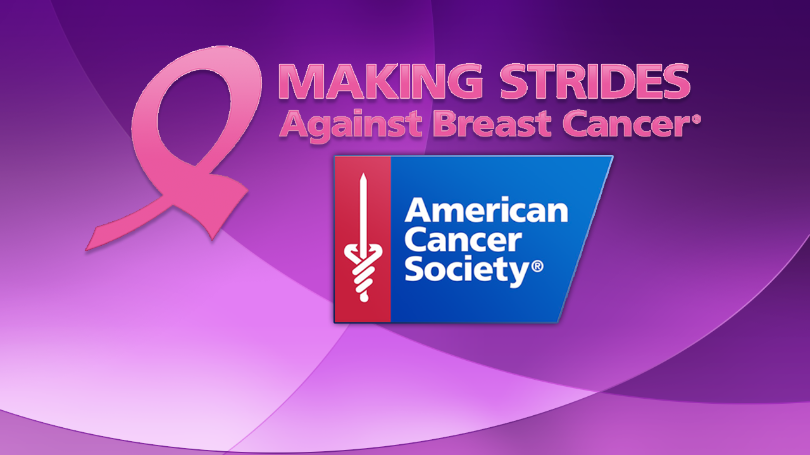Apart from skin cancers, breast cancer is the most common cancer type in women. In fact,
1 in 8 American women will be diagnosed in their lifetime
Making Strides
Against Breast Cancer.
But the good news is that, thanks in part to the efforts of the American Cancer Society and money raised through Making Strides Against Breast Cancer events, breast cancer incidence rates have been declining since 2000 and breast cancer deaths have been declining since 1989. Early detection has played a key role in the dramatic decrease.
Learn about breast cancer, prevention and early detection, treatment and support, and explore breast cancer research at cancer.org/breastcancer.
Learn More About Breast Cancer
In addition to making healthy lifestyle choices such as eating a healthy diet, getting regular physical activity, and limiting alcohol intake, the American Cancer Society also encourages regular breast cancer screening to find breast cancer early, when it is most likely to be curable.
American Cancer Society Recommendations for the Early Detection of Breast Cancer
Finding breast cancer early and getting state-of-the-art cancer treatment are the most important strategies to prevent deaths from breast cancer. Breast cancer that’s found early, when it’s small and has not spread, is easier to treat successfully. Getting regular screening tests is the most reliable way to find breast cancer early. The American Cancer Society has screening guidelines for women at average risk of breast cancer, and for those at higher-than-average risk for breast cancer.
What are screening tests?
The goal of screening tests for breast cancer is to find it before it causes symptoms (like a lump that can be felt). Screening refers to tests and exams used to find a disease in people who don’t have any symptoms. Early detection means finding and diagnosing a disease earlier than if you’d waited for symptoms to start.
Breast cancers found during screening exams are more likely to be smaller and still confined to the breast. The size of a breast cancer and how far it has spread are some of the most important factors in predicting the prognosis (outlook) of a woman with this disease.
American Cancer Society screenings recommendations for women at average breast cancer risk
These guidelines are for women at average risk for breast cancer. A woman at average risk doesn’t have a personal history of breast cancer, a family history of breast cancer, a genetic mutation known to increase risk of breast cancer (such as BRCA), and has not had chest radiation therapy before the age of 30. (See below for guidelines for women at higher than average risk.)
Women between 40 and 44 have the option to start screening with a mammogram every year.
Women 45 to 54 should get mammograms every year.
Women 55 and older can switch to a mammogram every other year, or they can choose to continue yearly mammograms. Screening should continue as long as a woman is in good health and is expected to live 10 more years or longer.
All women should be familiar with how their breasts normally look and feel and report any changes to a health care provider right away.
All women should understand what to expect when getting a mammogram for breast cancer screening – what the test can and cannot do.
Mammograms
Regular mammograms can help find breast cancer at an early stage, when treatment is most successful. A mammogram can find breast changes that could be cancer years before physical symptoms develop. Results from many decades of research clearly show that women who have regular mammograms are more likely to have breast cancer found early, are less likely to need aggressive treatment like surgery to remove the breast (mastectomy) and chemotherapy, and are more likely to be cured.
Mammograms are not perfect. They miss some cancers. And sometimes a woman will be need more tests to find out if something found on a mammogram is or is not cancer. There’s also a small possibility of being diagnosed with a cancer that never would have caused any problems had it not been found during screening. It‘s important that women getting mammograms know what to expect and understand the benefits and limitations of screening.
Clinical breast exam and breast self-exam
Research has not shown a clear benefit of physical breast exams done by either a health professional or by yourself for breast cancer screening. There is very little evidence that these tests help find breast cancer early when women also get screening mammograms. Because of this, a regular clinical breast exam and breast self-exam are not recommended. Still, all women should be familiar with how their breasts normally look and feel and report any changes to a health care provider right away.
American Cancer Society screening recommendations for women at higher than average risk
Women who are at high risk for breast cancer based on certain factors should get an MRI and a mammogram every year. This includes women who:
- Have a lifetime risk of breast cancer of about 20% to 25% or greater, according to risk assessment tools that are based mainly on family history (such as the Claus model – see below)
- Have a known BRCA1 or BRCA2 gene mutation
- Have a first-degree relative (parent, brother, sister, or child) with a BRCA1 or BRCA2 gene mutation, and have not had genetic testing themselves
- Had radiation therapy to the chest when they were between the ages of 10 and 30 years
- Have Li-Fraumeni syndrome, Cowden syndrome, or Bannayan-Riley-Ruvalcaba syndrome, or have first-degree relatives with one of these syndromes
The American Cancer Society recommends against MRI screening for women whose lifetime risk of breast cancer is less than 15%.
There’s not enough evidence to make a recommendation for or against yearly MRI screening for women who have a moderately increased risk of breast cancer (a lifetime risk of 15% to 20% according to risk assessment tools that are based mainly on family history) or who may be at increased risk of breast cancer based on certain factors, such as:
- Having a personal history of breast cancer, ductal carcinoma in situ (DCIS), lobular carcinoma in situ (LCIS), atypical ductal hyperplasia (ADH), or atypical lobular hyperplasia (ALH)
- Having “extremely” or “heterogeneously” dense breasts as seen on a mammogram
If MRI is used, it should be in addition to, not instead of, a screening mammogram. This is because although an MRI is more likely to detect cancer than a mammogram, it may still miss some cancers that a mammogram would detect.
Most women at high risk should begin screening with MRI and mammograms when they are 30 and continue for as long as they are in good health. But a woman at high risk should make the decision to start with her health care providers, taking into account personal circumstances and preferences.
Tools used to assess breast cancer risk
Several risk assessment tools, with names such as the Gail model, the Claus model, and the Tyrer-Cuzick model, are available to help health professionals estimate a woman’s breast cancer risk. These tools give approximate, rather than precise, estimates of breast cancer risk based on different combinations of risk factors and different data sets.
Because the different tools use different factors to estimate risk, they may give different risk estimates for the same woman. For example, the Gail model bases its risk estimates on certain personal risk factors, like current age, age at first menstrual period and history of prior breast biopsies, along with any history of breast cancer in first-degree relatives. In contrast, the Claus model estimates risk based only on family history of breast cancer in both first and second-degree relatives. These 2 models could easily give different estimates for the same person.
Risk assessment tools (like the Gail model, for example) that are not based mainly on family history are not appropriate to use with the ACS guidelines to decide if a woman should have MRI screening. The use of any of the risk assessment tools and its results should be discussed by a woman with her health care provider.

